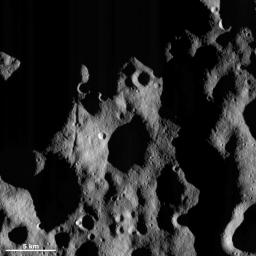This Dawn FC (framing camera) image shows an area in Vesta's northern hemisphere that has been illuminated more by the sun than yesterday's image of the day. More of the landscape in this image has been illuminated because this area is located at a slightly lower latitude than yesterday's image of the day. As Vesta progresses from its winter to its spring the sunlight is creeping further and further northwards. There are many craters visible in this image, which is consistent with this area being located in Vesta's heavily cratered northern hemisphere. There is also a distinctive groove, which is roughly 10 kilometers (6 miles) long, in the left center of the image that is highlighted by the sunlight.
This image is located in Vesta's Bellicia quadrangle and the center of the image is 47.0 degrees north latitude, 37.6 degrees east longitude. NASA's Dawn spacecraft obtained this image with its framing camera on Nov. 19, 2011. This image was taken through the camera's clear filter. The distance to the surface of Vesta is 272 kilometers (169 miles) and the image has a resolution of about 25 meters (82 feet) per pixel. This image was acquired during the transfer to LAMO (low-altitude mapping orbit) phase of the mission.
The Dawn mission to Vesta and Ceres is managed by NASA's Jet Propulsion Laboratory, a division of the California Institute of Technology in Pasadena, for NASA's Science Mission Directorate, Washington D.C. UCLA is responsible for overall Dawn mission science. The Dawn framing cameras have been developed and built under the leadership of the Max Planck Institute for Solar System Research, Katlenburg-Lindau, Germany, with significant contributions by DLR German Aerospace Center, Institute of Planetary Research, Berlin, and in coordination with the Institute of Computer and Communication Network Engineering, Braunschweig. The Framing Camera project is funded by the Max Planck Society, DLR, and NASA/JPL.
More information about the Dawn mission is online at http://www.nasa.gov/dawn and http://dawn.jpl.nasa.gov.

 Planetary Data System
Planetary Data System












